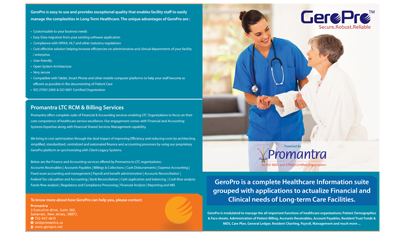Resident Care and Billing – Striking the Right Balance

Skilled Nursing Facilities (SNFs) operate at the crucial intersection of quality patient care and financial sustainability. Maintaining high standards of resident care while ensuring accurate and efficient billing can be a significant challenge. If facilities prioritize care without adequate financial oversight, they risk operational inefficiencies. Conversely, excessive focus on revenue can negatively impact patient satisfaction and compliance. This article explores how SNFs can effectively balance resident care and billing, implement best practices, and leverage technology to enhance both aspects of facility management.
The Challenge of Balancing Care and Billing
1. The Importance of Resident-Centered Care
Quality care in SNFs involves:
- Personalized treatment plans tailored to individual health needs.
- Timely medication administration and chronic disease management.
- Physical therapy and rehabilitation services.
- Support for emotional and social well-being.
Facilities must adhere to strict regulatory standards, including those set by the Centers for Medicare & Medicaid Services (CMS) and state health agencies.
2. The Need for Financial Viability
While resident care is the priority, SNFs must also ensure they:
- Receive timely reimbursements from Medicare, Medicaid, and private insurers.
- Minimize billing errors and claim denials.
- Optimize the Patient-Driven Payment Model (PDPM) to accurately reflect care.
- Manage operational costs efficiently.
Striking a balance requires a structured approach to billing that supports quality care without overwhelming staff with administrative burdens.
Common Billing Challenges That Impact Resident Care
1. Underbilling and Overbilling Risks
- Underbilling can lead to revenue losses and financial strain, ultimately reducing resources available for resident care.
- Overbilling results in compliance risks, penalties, and potential audits from Medicare and Medicaid.
Case Study: A Texas SNF faced a $500,000 penalty after CMS identified discrepancies in therapy billing. To prevent future errors, they implemented automated billing reviews, which reduced discrepancies by 40%.
2. Claim Denials Due to Documentation Issues
- Insufficient documentation of medical necessity can lead to claim rejections.
- Incomplete or incorrect coding results in delays in reimbursement.
- Late submissions can result in lost revenue.
Best Practice: Facilities should train staff on ICD-10 coding and PDPM guidelines, conduct regular audits, and utilize billing software to flag errors before submission.
3. Regulatory Compliance and Financial Penalties
Regulatory violations related to billing can lead to significant fines and legal repercussions. Compliance with:
- HIPAA regulations ensure patient data security.
- CMS guidelines help prevent fraudulent claims.
- State-specific Medicaid rules ensure timely reimbursements.
Example: An Illinois-based SNF implemented real-time billing compliance checks, reducing compliance-related claim denials by 30%.
Best Practices for Aligning Resident Care with Billing
1. Implement a Patient-Driven Revenue Cycle
The Patient-Driven Payment Model (PDPM) allows SNFs to bill based on the patient’s clinical complexity rather than therapy volume.
Steps to optimize PDPM billing:
- Conduct comprehensive resident assessments upon admission.
- Ensure interdisciplinary team collaboration for accurate care documentation.
- Use electronic health records (EHRs) integrated with billing systems for real-time updates.
2. Strengthening Staff Training on Billing and Care Documentation
Billing teams and clinical staff should undergo regular training on:
- Medicare and Medicaid policies.
- Proper documentation techniques to justify the services provided.
- Updated coding systems (ICD-10, CPT, and HCPCS).
Case Study: A Florida SNF reduced claim denials by 25% after introducing a monthly training program on PDPM coding.
3. Utilize Advanced Billing and EHR Systems
An integrated EHR and billing system reduces paperwork, enhances efficiency, and minimizes errors.
Key Benefits:
- Automated claim processing for faster reimbursements.
- Real-time eligibility verification for insurance coverage.
- Error detection tools that flag missing or incorrect entries.
Example: A California-based SNF improved its reimbursement rate by 20% after implementing AI-driven billing software.
4. Develop a Proactive Financial Management Strategy
To ensure long-term financial stability while prioritizing care:
- Monitor Key Performance Indicators (KPIs), such as average reimbursement rates and days in accounts receivable.
- Conduct regular audits to identify and correct billing discrepancies.
- Optimize payer mix strategies to maximize revenue.
Best Practice: A New York SNF implemented quarterly billing audits, leading to a 10% reduction in missed charges and increased revenue flow.
5. Engage Families and Residents in Financial Discussions
Clear communication with residents and their families helps avoid billing disputes and ensures transparency.
Effective Strategies:
- Provide financial counseling at admission.
- Offer payment plan options for out-of-pocket expenses.
- Use digital portals where families can track billing statements and insurance claims.
Example: A Pennsylvania SNF saw a 15% drop in unpaid patient balances after launching an online billing portal for residents’ families.
How LTCPro Can Help Balance Resident Care and Billing
LTCPro is an end-to-end financial and care management software tailored for SNFs, ensuring seamless integration of billing, compliance, and resident care.
Key Features of LTCPro:
- Automated PDPM Optimization – Ensures accurate reimbursement based on patient conditions.
- Integrated EHR and Billing System – Synchronizes medical records with financial transactions.
- AI-Powered Claim Management – Reduces errors and speeds up processing times.
- Real-Time Compliance Monitoring – Flags potential Medicare/Medicaid violations.
- Financial Reporting Dashboard – Provides insights into revenue trends and reimbursement performance.
Case Study: A Tennessee SNF using LTCPro reduced billing discrepancies by 35% and improved claim approval rates by 22% within six months.
Finding the right balance between resident care and efficient billing is crucial for sustained success in skilled nursing facilities. By implementing PDPM optimization, advanced billing technology, compliance strategies, and staff training, SNFs can maintain high care standards while ensuring financial health.
Key Takeaways:
- Accurate billing ensures financial stability without compromising patient care.
- PDPM-based reimbursement models support patient-centered billing.
- Technology-driven solutions minimize billing errors and enhance efficiency.
- Transparent financial discussions with families reduce disputes and unpaid balances.
- LTCPro streamlines billing, compliance, and operational workflows for SNFs.
Enhancing your SNF’s financial performance while delivering quality care is achievable—consider exploring LTCPro today.
A perfect fit for Skilled Nursing Facilities, Assisted Living Facilities, Home Health, Hospice and Other Day Care Centres.
Download BrochureRequest a demo


























